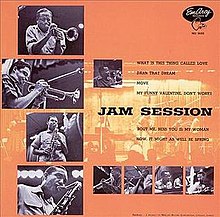
Requisites
Jam Session is the first of two albums that comprised a two-part EmArcy Jazz Series recorded in front of a live audience on August 14, 1954, in Los Angeles, California.
Track Listing | 46:47- What Is This Thing Called Love? (Cole Porter) – 14:56
- Darn That Dream (Eddie DeLange, Jimmy Van Heusen) – 5:16
- Move (Denzil Best) – 14:28
- My Funny Valentine/Don’t Worry ’bout Me/Bess, You Is My Woman Now/It Might as Well Be Spring (Lorenz Hart, Richard Rodgers/Rube Bloom, Ted Koehler/George Gershwin, Ira Gershwin/Oscar Hammerstein II, Rogers) – 11:29
- Clifford Brown, Maynard Ferguson, Clark Terry ~ trumpet Herb Geller ~ alto saxophone (1,3,4)
- Harold Land ~ tenor saxophone
- Junior Mance (1,3,4), Richie Powell (2) ~ piano
- Keter Betts, George Morrow ~ bass
- Max Roach ~ drums
- Dinah Washington ~ vocal (2)
The album is opened with a spirited introduction by Roach preceding the ensemble presenting the melody collectively of Cole Porter’s 1929 classic What Is This Thing Called Love? written for the Broadway musical, Wake Up and Dream. Clifford is up first, revealing a musical maturity far beyond his years on the opening statement with a solo of dynamic energy. Land endows the next solo with long, flowing lines as Terry strolls in with his third performance for an impressive and entertaining interpretation.
Geller demonstrates the smooth, melodic quality of his playing with a light, fluid tone on the fourth reading and Morrow takes over illustrating his agility and potent endurance. Ferguson maintains the interpretative intensity and fullness of tone with Roach’s tower of strength swinging relentlessly. Powell takes the final bow hitting a perfect groove with plenty of incandescent heat. This is how the album flows.
Dinah Washington makes her only appearance on the album with the 1939 Jimmy Van Heusen and Eddie DeLange popular ballad, Darn That Dream. The song was introduced in the Broadway musical, Swingin’ The Dream, also released in 1939. Dinah’s luscious lyric delivery is with exquisite softness and elegant phrasing into a gorgeous finale to end the first side. Though only appearing once on this album, Washington recorded its companion Dinah Jams the following night as part of the same series. Both are enjoyable at any time of the day or evening with something to offer most jazz tastes.
Source: Jazztracks by Eddie Carter | Excerpt: 12/2018 | atlantaaudioclub.org
More Posts: choice,classic,collectible,collector,history,instrumental,jazz,music


